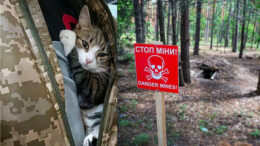Saving Ukraine’s injured and displaced animals during wartime often means seeing the worst elements of Russian cruelty.
“When a territory is liberated, our team goes there and we speak with the people who survived the occupation,” says Olga Chevhanyuk, chief operating officer of UAnimals, Ukraine’s largest animal-rights organization. “And each time we hear that when the Russians entered the town, they started shooting animals for fun, starting with dogs just walking the streets and ending with huge farms and shelters. Sometimes it’s probably a matter of manipulation, getting people scared. But mostly it’s no reason at all, just because they can.”
Originally founded to oppose inhumane conditions in circuses, the nonprofit UAnimals has shifted its mission to rescuing and caring for domestic animals and wildlife devastated by Russian aggression.
Working with local volunteers and shelters, they’ve helped tens of thousands of animals since the war began a year ago, including dogs and cats, horses, deer, swans, birds of prey and bats — even large predators like bears. In January alone they rescued more than 9,600 animals, provided food and medicine to thousands more, rebuilt shelters, and helped fund operations throughout the country.
View this post on Instagram
They’ve also found themselves purchasing supplies not traditionally used in animal rescues.
“Before the war, you never think of buying helmets for your team,” Chevhanyuk says.
And then there’s the human toll: The nonprofit has contracted with psychologists to provide on-demand assistance to its team in the field. “So now they can have a session with the psychologist when they’re overwhelmed,” she says.
But this is all about saving more than individual animal lives and human minds. It’s about saving the soul of a country.
A Crime Against Nature
UAnimals has started calling the Russian war an ecocide — the deliberate destruction of the natural environment.
“Nowadays 20% of Ukraine’s nature conservation areas are affected by war,” Chevhanyuk says. “Russians occupy eight national reserves and 12 national parks, and some of the national parks are land-mined. Holy Mountains National Park is 80% destroyed. Some of them are destroyed 100%, meaning there’s no plants, no animals, no buildings which people used to heal animals. The land is littered with remains of destroyed objects, like tons of oil and burned products.”
Landmines are among the worst problems. They kill humans and animals indiscriminately, start fires, and will take years to mitigate. About 62,000 square miles of Ukraine may be contaminated with landmines. “This is greater than the size of Illinois,” according to information provided by a U.S. State Department official. “The United States is investing $91.5 million over the coming year to help the government of Ukraine address the urgent humanitarian challenges posed by explosive remnants of war created by Russia’s invasion.”
Cleaning up the pollution will require even more funding and effort. The war has caused at least $37 billion in environmental damage, a Ukrainian NGO said in November.
View this post on Instagram
UAnimals predicts it could take more than a decade to repair the damage, but Ukraine’s wildlife doesn’t have that much time. “More than 80 species of animals in our country are on the verge of extinction and may completely cease to exist due to Russian aggression,” Chevhanyuk says. “Some of them are the steppe eagle, black stork, brown bear, Eurasian lynx, barn owl and eared hedgehog.”
While many of these species also exist in other countries, Chevhanyuk says wildlife has been an important element of Ukrainian folksongs, art and symbology — the very fabric of its culture — for centuries. “Being humane and treating animals as something really important and equal — this is one of the things which differs us a lot from Russians. And that’s, I believe, a part of our future victory.”
Moving Forward
UAnimals continues to ramp up its fundraising and recovery efforts while expanding its network of shelters outside the country — a necessary step, as Ukrainian shelters and reserves are rapidly filling to capacity with animals too wounded ever to be released back into the wild.
“We have big shelters for bears, for example,” Chevhanyuk says, “but they are already full. I’m afraid that if something happens, we’ll need to bring these animals abroad. So we are very grateful to all our partners in different countries, because there’s a big need right now.”
The organization is also tapping back into its activist roots to bring international attention to conditions in Ukraine. In February they organized Stop Ecocide Ukraine rallies in four U.S. cities — Atlanta, Austin, New York and San Antonio — that each attracted hundreds of people.
View this post on Instagram
In a way this is a return to form. “We used to create huge animal-rights marches in 30 Ukrainian cities every September,” Chevhanyuk says. “But since war started, we are more focused on the emergency.”
And the international community has started to take notice. Last month the Parliamentary Assembly of the Council of Europe passed a resolution to “build and consolidate a legal framework for the enhanced protection of the environment in armed conflicts” — steps that support establishing ecocide as a new international crime.
“From a legal perspective, this is really encouraging,” says Jojo Mehta, cofounder and executive director of Stop Ecocide International, “because if you put severe harm to the living world on the same level as severe harm to people, if you say ecocide is as bad, wrong and dangerous as genocide, you’re creating a mental rebalance.”
It could still take years for ecocide to become international law. But meanwhile the destruction of Ukraine continues, as do recovery efforts.
“If our team knows there is an animal to rescue,” Chevhanyuk says, “they will go in.”
Previously in The Revelator:
20 Endangered Species at Risk in Ukraine
![]()


